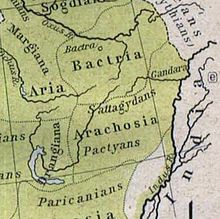Different opinions have been expressed about the extent of the Median kingdom. For instance, according to Ernst Herzfeld, it was a powerful empire, which stretched from north Mesopotamia to Bactria and India. On the other side, Heleen Sancisi-Weerdenburg insists that there is no real evidence about the very existence of the Median Empire and that it was an unstable state formation.
ACHAEMENID EMPIRE
Arachosia, Aria and Bactria were the ancient satraps of the Achaemenid Empirethat made up most of what is now Afghanistan during 500 BCE some of the inhabitants of Arachosia were known asPactyans, whose name possibly survives in today’s Pakhtuns (Pashtuns).
Afghanistan became part of the Achaemenid Empire, after it was conquered by Darius I of Persia. The area was divided into several provinces called satrapies, which were each ruled by a governor, or satrap. These ancient satrapies included: Aria(Herat); Arachosia (Kandahar, Lashkar Gah, and Quetta); Bactriana (Balkh); Sattagydia (Ghazni); and Gandhara (Kabul, Jalalabad, Peshawar).
Alexander and the Seleucids
Alexander the Great arrived in the area of Afghanistan in 330 BCE after defeating Darius III of Persia a year earlier at the Battle of Gaugamela. His army faced very strong resistance in the Afghan tribal areas where he is said to have commented that Afghanistan is “easy to march into, hard to march out of.”[2] Although his expedition through Afghanistan was brief, Alexander left behind a Hellenic cultural influence that lasted several centuries. Several great cities were built in the region named “Alexandria,” including: Alexandria-of-the-Arians (modern-day Herat); Alexandria-on-the-Tarnak (near Kandahar); Alexandria-ad-Caucasum (near Begram, at Bordj-i-Abdullah); and finally, Alexandria-Eschate (near Kojend), in the north. After Alexander’s death, his loosely connected empire was divided. Seleucus, a Macedonian officer during Alexander’s campaign, declared himself ruler of his own Seleucid Empire, encompassing Persia and Afghanistan.
Greco-Bactrian Kingdom
Approximate maximum extent of theGreco-Bactrian kingdom circa 180 BCE, including the regions of Tapuria andTraxiane to the West, Sogdiana andFerghana to the north, Bactria andArachosia to the south.
The Greco-Bactrian Kingdom was founded when Diodotus I, the satrap of Bactria (and probably the surrounding provinces) seceded from the Seleucid Empire around 250 BCE. Greco-Bactria continued until c. 130 BCE, when Eucratides’ son, King Heliocles I, was defeated and driven out of Bactria by the Yuezhi tribes. It is thought that his dynasty continued to rule in Kabul and Alexandria of the Caucasus until 70 BCE when King Hermaeus was defeated by the Yuezhi.
One of Demetrius’ successors, Menander I, brought the Indo-Greek Kingdom to its height between 165–130 BCE, expanding the kingdom in India to even larger proportions than Demetrius. After Menander’s death, the Indo-Greeks steadily declined and the last Indo-Greek king was defeated in c. 10 CE.
Mauryan Empire
Modern day Afghanistan was conquered by the Maurya Empire, which was led by Chandragupta Maurya from Magadha (modern day Bihar in India). They were Indians who practiced Hinduism and Buddhism and were focusing on taking over Central Asia. Seleucus is said to have reach a peace treaty with Chandragupta by given control of the territory south of the Hindu Kush to the Mauryas upon intermarriage and 500 elephants.
Alexander took these away from the Indo-Aryans and established settlements of his own, but Seleucus Nicator gave them to Sandrocottus (Chandragupta), upon terms of intermarriage and of receiving in exchange 500 elephants.
Some time after, as he was going to war with the generals of Alexander, a wild elephant of great bulk presented itself before him of its own accord, and, as if tamed down to gentleness, took him on its back, and became his guide in the war, and conspicuous in fields of battle. Sandrocottus, having thus acquired a throne, was in possession of India, when Seleucus was laying the foundations of his future greatness; who, after making a league with him, and settling his affairs in the east, proceeded to join in the war against Antigonus. As soon as the forces, therefore, of all the confederates were united, a battle was fought, in which Antigonus was slain, and his son Demetrius put to flight.
—Junianus Justinus
Having consolidated power in the northwest, Chandragupta pushed east towards the Nanda Empire. Afghanistan’s significant ancient tangible and intangible Buddhist heritage is recorded through wide-ranging archeological finds, including religious and artistic remnants. Buddhist doctrines are reported to have reached as far as Balkh even during the life of the Buddha (563 BCE to 483 BCE), as recorded by Husang Tsang.
In this context a legend recorded by Husang Tsang refers to the first two lay disciples of Buddha, Trapusa and Bhallika responsible for introducing Buddhism in that country. Originally these two were merchants of the kingdom of Balhika, as the name Bhalluka or Bhallika probably suggests the association of one with that country. They had gone to India for trade and had happened to be at Bodhgaya when the Buddha had just attained enlightenment.
The Hephthalite Empire in Afghanistan extended from Chinese Sinkiang to Sassanid Iran, from Sogdiana to the Punjab. Their chief antagonists were the Sassanids. Consequently there was relatively little peace during this time. At about 565 CE, the Hephthalite Empire was overthrown by a combined force consisting of western Turks and Sassanids.


